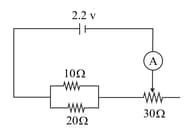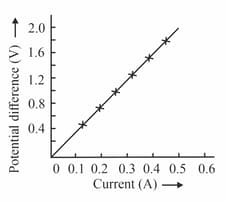Which among the following graphs correctly represents ohms law?
Important Questions on Electric Current
The values of current () flowing through a given resistor of resistance (), for the corresponding values of potential difference () across the resistor, are as given below:
| (volts) | ||||||||
| (amperes) |
Plot a graph between current () and potential difference () and determine the resistance () of the resistor.
A student carries out an experiment and plots the V-I graph of three samples of nichrome wire with resistance and respectively. Which of the following given condition is true?

Establish relation between potential difference and electric current by plotting graph.
graph for parallel and series combinations for two identical resistors are as shown in figure.Which graph represents parallel combination?


The resistance of rheostat shown in the figure is , Neglecting the resistance of ammeter and connecting wire the minimum and maximum currents through the ammeter will be

Consider an infinite grid with square cells. The resistance between two adjacent joints is Find the net resistance of the whole grid between two points A & B.

Following figures shows graph of . Which graph is correct according to Ohm's law?

Write Ohm's law. Draw a circuit diagram to prove it experimentally in the laboratory.
A graph for a nichrome wire is given below. What do you infer from this graph? Draw a labelled circuit diagram to obtain such a graph.

In figure and a battery is connected to the arrangement. Calculate:
(a) Total resistance in the circuit.
(b) Total current flowing in the circuit.

How is the concept of resistance obtained from Ohm's law?
For a cell, a graph is plotted between the potential difference across the terminals of the cell and current drawn from the cell (see fig.) The emf and internal resistance of the cell are and respectively, then :

The potential difference between the two ends of a conductor is , and the current flowing through the conductor is . At a constant temperature, which of the following statement is true for the conductor?

